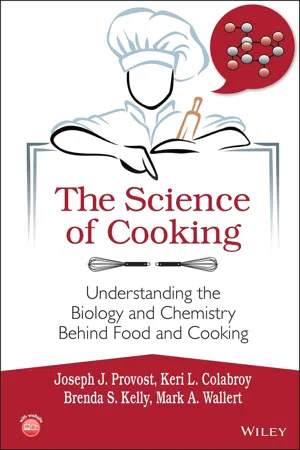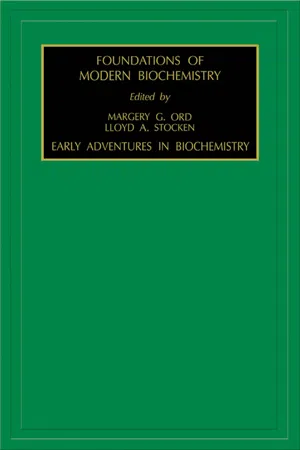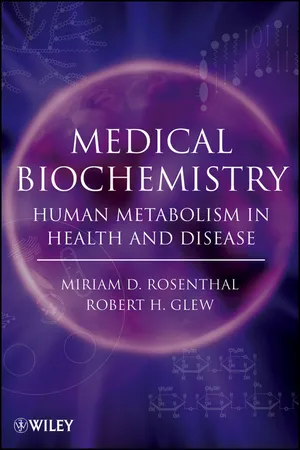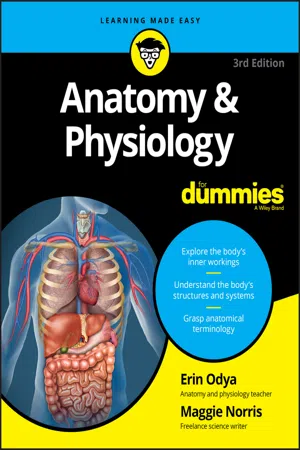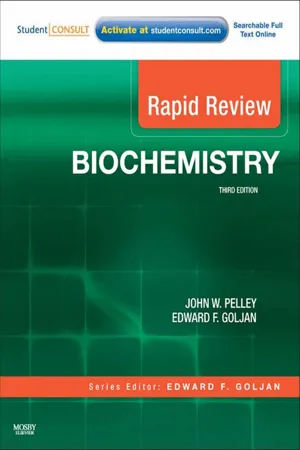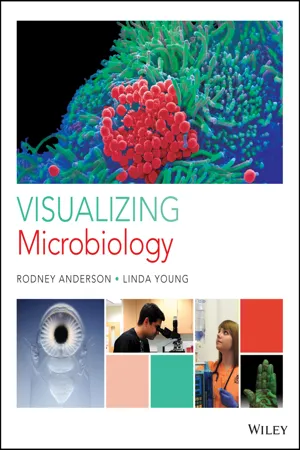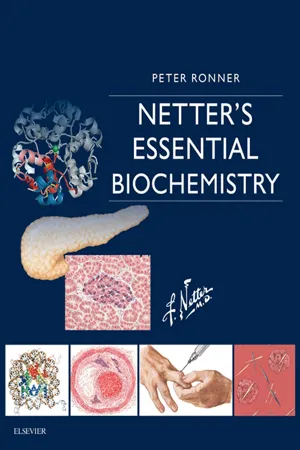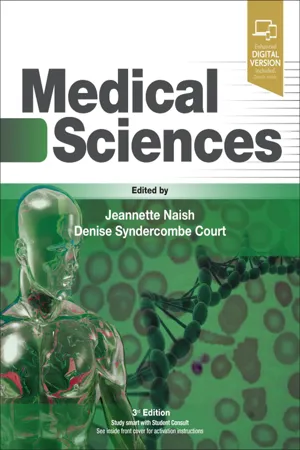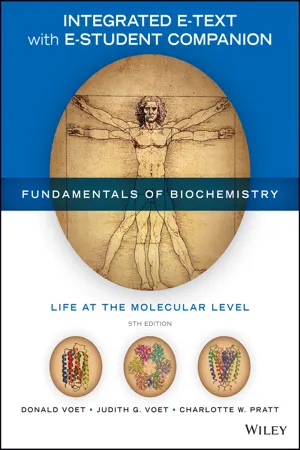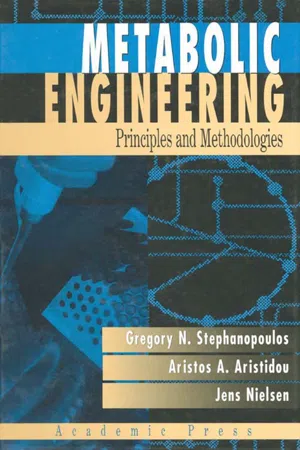Biological Sciences
Glycolysis
Glycolysis is the metabolic pathway that breaks down glucose into pyruvate, generating ATP and NADH in the process. It occurs in the cytoplasm and is the first step in both aerobic and anaerobic respiration. Glycolysis consists of 10 enzymatic reactions, ultimately producing two molecules of pyruvate, two molecules of ATP, and two molecules of NADH from one molecule of glucose.
Written by Perlego with AI-assistance
Related key terms
Related key terms
1 of 4
Related key terms
1 of 3
11 Key excerpts on "Glycolysis"
- eBook - ePub
The Science of Cooking
Understanding the Biology and Chemistry Behind Food and Cooking
- Joseph J. Provost, Keri L. Colabroy, Brenda S. Kelly, Mark A. Wallert(Authors)
- 2016(Publication Date)
- Wiley(Publisher)
Most organisms are also able to carry out anaerobic respiration or fermentation, which doesn’t require the presence of oxygen. Anaerobic respiration generates less energy for the organism, as there is no net oxidation of the glucose molecule; however it is an essential process for organisms to survive in situations where there is an absence of or limited amounts of oxygen. Some organisms even prefer to carry out fermentation! Although there are major differences in the energy generated and oxidation processes for an organism under aerobic versus anaerobic conditions, both processes initially break down glucose using the same pathway called Glycolysis.4.4.1 Glycolysis
Glycolysis, derived from the Greek roots glykos, meaning sweet, and lysis, meaning “loosening” or “splitting,” involves a sequence of 10 enzyme-catalyzed reactions that converts one six-carbon molecule of glucose into two three-carbon molecules of pyruvate. The first five steps of the pathway are called the “investment” or the “preparatory” phase of Glycolysis because energy is consumed (see the use of an ATP molecule in step one) to break the six-carbon glucose molecule into two three-carbon units. The next few steps are referred to as the payoff phase of Glycolysis, as they include an oxidation reaction that generates NADH and that generate ATP through direct addition of a high-energy phosphate from PEP to ATP in a process called substrate-level phosphorylation (Fig. 4.10 ). The final product of Glycolysis is pyruvate; from a single molecule of glucose, two molecules of pyruvate are generated.Glycolysis. The glycolitic pathway involved in fermentation to produce ATP.Figure 4.10Any metabolic pathway, including Glycolysis, is often viewed as a complicated series of enzymes, substrates, and products. However, all metabolic pathways do have some common themes. The name of the enzyme often describes the features of the reaction it catalyzes. For example, step one of Glycolysis is catalyzed by hexokinase. Hex is the prefix that is associated with six (in this case the six-carbon glucose), and kinase - eBook - ePub
- L.A. Stocken, M.G. Ord(Authors)
- 1995(Publication Date)
- Elsevier Science(Publisher)
Chapter 4Carbohydrate Utilization: Glycolysis and Related Activities
Introduction
The term “Glycolysis” was introduced by Lepine (1909) to describe the disappearance of carbohydrate during metabolism. It is now used for the breakdown of glycogen or glucose that occurs anaerobically through pyruvate to give lactic acid in liver and muscle or ethanol in yeast. The glycolytic route was the first biochemical pathway to be established; all its enzymes have been sequenced and many of their three-dimensional structures determined, as well as mechanisms whereby the enzymes catalyze the different reactions. Identification of the sugar phosphate esters involved in the pathways led directly to the discovery of phosphocreatine, ATP and the realization of the importance of ATP as the energy currency of cells (Lipmann,1941).Two other features associated with Glycolysis will be considered. The breakdown of liver glycogen and release of blood glucose observed by Claude Bernard formed the basis of his ideas on glucose homeostasis; by the 1950s detailed analysis of these reactions and of the formation of liver glycogen provided the groundwork for the explosive and continuing development of molecular endocrinology.Microscopists in the nineteenth century had begun to describe changes in the appearance of muscle fibers during contraction. Their experiments were concurrent with those of physiologists examining the relation between the work done by striated muscle and its heat production. Studies of Glycolysis in muscle and the investigation of muscle contraction provided an early example of the strengths and difficulties of interdisciplinary collaboration.Development of Analytical Techniques
The discovery (see below) by the Buchners that cell-free preparations from yeast were able to ferment glucose, was exploited by Harden and Young who showed that inorganic phosphate was an essential component in the fermentation process. Analysis of the glycolytic intermediates required procedures by which different phosphorylated sugars could be identified and estimated (Umbreit et al., 1945) - eBook - ePub
Medical Biochemistry
Human Metabolism in Health and Disease
- Miriam D. Rosenthal, Robert H. Glew(Authors)
- 2011(Publication Date)
- Wiley(Publisher)
CHAPTER 4Glycolysis4.1 FUNCTIONS OF Glycolysis
Glycolysis is a metabolic pathway that cleaves glucose into two molecules of pyruvate or lactate. During Glycolysis, some of the energy in the glucose molecule is converted into ATP. Although Glycolysis to pyruvate is an oxidative process, it is not dependent on molecular oxygen. By contrast, the subsequent fate of pyruvate depends on the presence of both mitochondria and sufficient oxygen. In the presence of oxygen, the product of Glycolysis is pyruvate, which is further oxidized by the pyruvate dehydrogenase enzyme complex and the dehydrogenases of the tricarboxylic acid (TCA) cycle. In the absence of sufficient oxygen, or in red blood cells, where mitochondria are absent, lactate is the final product of Glycolysis and there is no net oxidation. Glycolysis is not only the major pathway for oxidizing glucose, but also the main pathway for metabolizing other dietary sugars, such as galactose and fructose.Once glucose has been trapped inside a cell in the form of glucose 6-phosphate, there may be as many as three metabolic options available for the glucose moiety (Fig. 4-1 ). In a hepatocyte, for example, glucose can be oxidized via Glycolysis for the primary purpose of ATP production, stored as glycogen, or oxidized in the pentose phosphate pathway to generate NADPH and ribose for nucleic acid synthesis. Red blood cells, on the other hand, cannot synthesize glycogen; they can, however, metabolize glucose through the pentose phosphate pathway or through Glycolysis.Three possible metabolic fates of glucose: Glycolysis, the pentose phosphate pathway, and glycogen synthesis.FIGURE 4-14.1.1 Glycolysis Provides Energy
The main function of Glycolysis is energy (ATP) production. The conversion of one molecule of glucose to pyruvate or lactate is associated directly with the net production of two ATP molecules. Since the maximum number of ATP molecules that can be realized from the complete oxidation of one molecule of glucose to CO2 - eBook - ePub
- R. Michael Akers, D. Michael Denbow(Authors)
- 2013(Publication Date)
- Wiley-Blackwell(Publisher)
Figure 3.4 . At this point, it is worth remembering the significance of Glycolysis. This pathway allows the conversion of the nutrient glucose into molecules that can then be shuttled into the mitochondria for use in the process of oxidative phosphorylation. However, as we indicated earlier, oxidative phosphorylation (simply the production of ATP linked to a series of oxidation–reduction reactions) requires oxygen. In addition to preparing molecules for entrance into the mitochondria, a small amount of ATP is produced during the Glycolysis reactions. In contrast with mitochondrial activity, this occurs via substrate-level phosphorylation. As you will see, the amount of ATP made in this manner is very small compared with that which occurs with the complete catabolism of the glucose (Glycolysis reactions + mitochondrial activity), but it is nonetheless essential. This is because production of ATP via Glycolysis alone can occur in the absence of oxygen. For this reason, it is called anaerobic respiration.Table 3.2.Common terms associated with the metabolism of carbohydrates.Term Definition Glycolysis Anaerobic oxidation of a molecule of glucose via 10 enzymatic reactions to produce two molecules of pyruvate. The reactions occur in the cytoplasm. Glycogenolysis The breakdown of glycogen to produce glucose for utilization in the Glycolysis catabolic pathway. Glycogenesis Synthesis of glycogen from glucose. Gluconeogenesis The formation of glucose from noncarbohydrate substrates. Important in times of stress, makes glucose available from nonessential amino acids. Critical in ruminants due to fermentation of dietary carbohydrates. Fig. 3.3.Chemical steps and intermediates in Glycolysis are illustrated.Fig. 3.4. - eBook - ePub
- Erin Odya, Maggie A. Norris(Authors)
- 2017(Publication Date)
- For Dummies(Publisher)
Note: Alcohol fermentation is included for reference but does not occur in the human body.)Here, we focus on the ins and outs of the three main components of cellular respiration.© John Wiley & Sons, Inc.FIGURE 2-2: Cellular respiration: Glycolysis, aerobic (Krebs cycle) and anaerobic respiration, and oxidative phosphorylation, all of which convert energy from fuel into ATP.Glycolytic pathway (Glycolysis)
Starting at the top of Figure 2-2 , you can see that glucose — the smallest molecule that a carbohydrate can be broken into during digestion — goes through the process of Glycolysis, which starts cellular respiration and uses some energy (ATP) itself. Glycolysis occurs in the cytoplasm and doesn’t require oxygen. Two molecules of ATP are required to start each molecule of glucose rolling down the glycolytic pathway; although four molecules of ATP are generated during Glycolysis, the net production of ATP is two molecules. In addition to the two ATPs, two molecules of pyruvic acid (also called pyruvate ) are generated. They move into a mitochondrion and enter the Krebs cycle.Krebs cycle
The Krebs cycle is a major biological pathway in the metabolism of every multicellular organism. It’s an aerobic pathway, requiring oxygen.As the pyruvate enters the mitochondrion, a molecule called nicotinamide adenine dinucleotide (NAD+) joins it. NAD+ is an electron carrier (that is, it carries energy), and it gets the process moving by bringing some energy into the pathway. The NAD+ provides enough energy that when it joins with pyruvate, carbon dioxide is released, and the high-energy molecule NADH is formed. Flavin adenine dinucleotide (FAD) works in much the same way, becoming FADH2 . The product of the overall reaction is acetyl coenzyme A - eBook - ePub
Rapid Review Biochemistry
Rapid Review Biochemistry E-Book
- John W. Pelley, Edward F. Goljan(Authors)
- 2010(Publication Date)
- Mosby(Publisher)
Chapter 6 Carbohydrate MetabolismI. Glycolysis and the Fate of PyruvateA. Overview 1. Glycolysis is composed of five reactions that consume ATP and five reactions that produce ATP. 2. Pyruvate dehydrogenase catalyzes three reactions within the same multienzyme complex. 3. Glycolysis is regulated at three points: hexokinase, phosphofructokinase (PFK), and pyruvate kinase. 4. Pyruvate dehydrogenase is regulated by covalent modification with phosphorylation.5. Glycolysis interfaces with glycogen metabolism, the pentose phosphate pathway, the formation of amino sugars, triglyceride synthesis (by means of glycerol 3-phosphate), the production of lactate (a dead-end reaction), and transamination with alanine.6. Pyruvate dehydrogenase interfaces with other pathways such as the citric acid cycle or fat synthesis through its product, acetyl CoA. 7. Lactic acidosis is caused by overproduction of pyruvate or NADH. 8. Deficiencies in any of the pyruvate dehydrogenase enzymes produce lactic acidosis.B. Glycolysis and pyruvate oxidation: pathway reaction steps (Fig. 6-1 )1. Step 1a. Phosphorylation of glucose to glucose 6-phosphate, the first regulated step in Glycolysis, is irreversible and traps glucose inside the cell.6-1 Steps in Glycolysis. The regulated steps in Glycolysis are indicated by one-way arrows and boxed enzymes. Reversible reactions are identified by two-way arrows. Interfaces with other pathways are also identified. BP, bisphosphate; MetHb, methemoglobin; P, phosphate; PFK, phosphofructokinase.Phosphorylation: traps glucose in the cell - eBook - ePub
- Rodney P. Anderson, Linda Young(Authors)
- 2016(Publication Date)
- Wiley(Publisher)
a. Complete glucose oxidationA highly exergonic reaction, glucose catabolism liberates 686 kcal/mol.b. A comparison of glucose oxidation practicesWhen glucose is oxidized in a single step, an enormous activation energy barrier must be overcome and the energy is released as wasteful, potentially damaging heat. The small activation energy barriers in multistep glucose oxidation are overcome by enzymes, and the energy harvested is stored in activated carriers.The catabolic reactions of cellular respiration, beginning with Glycolysis, provide aerobic cells with energy in the form of ATP that they need for life.Ask Yourself
Are the reactants and products the same in the direct combustion of glucose and in the stepwise oxidation of glucose?Glycolysis
Harvesting energy from glucose involves three metabolic pathways: Glycolysis, followed by either fermentation or cellular respiration.Glycolysismeans sugar splitting, and the process oxidizes a single glucose into two pyruvate molecules. Additionally, there is a net production of two ATP via substrate-level phosphorylation and twoNAD+molecules are reduced to two NADH molecules. Glycolysis is a universal process. All organisms from archaea to humans perform this series of biochemical reactions to extract energy from glucose (Figure 7.7 ).GlycolysisA series of 10 enzyme-mediated catabolic reactions that occur in the cytoplasm and degrade glucose into two molecules of pyruvate and generate two NADH molecules and two ATP molecules.PROCESS DIAGRAM
Glycolysis is the initial series of glucose-oxidizing reactions performed by all cells to generate ATP.Glycolysis: The common metabolic pathway • Figure 7.7a. The energy-consuming reactionsTwo ATP molecules are invested to prepare the hexose for enzymatic cleavage into two trioses.b. The energy-generating reactions - eBook - ePub
Netter's Essential Biochemistry E-Book
Netter's Essential Biochemistry E-Book
- Peter Ronner(Author)
- 2016(Publication Date)
- Elsevier(Publisher)
▪ Heritable deficiencies of enzymes of Glycolysis are quite rare. In red blood cells, they give rise to hemolytic anemia.1. Chemical Reactions of Glycolysis
Glycolysis produces two molecules of pyruvate per molecule of glucose.Glucose transporters move glucose between the extracellular and the intracellular space (see Section 3 in Chapter 18 and Table 18.1 ). Glycolysis takes place in the cytosol.The reactions of Glycolysis are shown in Fig. 19.2 . The net reaction of Glycolysis is:Glucose + 2 ADP + 2 phosphate + 2NAD +→ 2 pyruvate + 2 ATP + 2 NADH + 2H ++ 2H 2OFig. 19.2 Reactions of Glycolysis. NaF is used clinically to inhibit Glycolysis in blood samples.All cells are capable of Glycolysis. As detailed in Section 4 , several intermediates and products of Glycolysis constitute a starting or end point for other metabolic pathways (see Fig. 19.11 ).There are no plasma membrane transporters for the phosphorylated intermediates of Glycolysis, and the lipid bilayer does not allow them to pass through.Enzymes that catalyze irreversible reactions are regulated as described in Sections 3 and 5 below. Enzymes that catalyze reversible reactions are not regulated.Glycolysis by itself yields a modest amount of ATP (see Fig. 19.2 ). Early in the pathway, ATP is consumed, but ATP is later produced such that the return is greater than the initial investment. The conversion of glucose to pyruvate yields two ATP and 2 NADH. In anaerobic Glycolysis, explained in Section 2 , the net gain is two ATP, while in aerobic Glycolysis, the gain is about 5 to 7 ATP because NADH can also give rise to ATP (see Section 2 and Chapter 23 ).In Glycolysis,NAD+serves as an electron acceptor (i.e., as an oxidizing agent; see Figs. 19.2 and 19.3 ). NAD+ is an abbreviation of nicotinamide adenine dinucleotide. The pyridine ring of NAD+ is the electron acceptor. The nitrogen of the pyridine ring is positively charged, and hence it is commonplace to write this species as NAD+ ; however, at physiologic pH, NAD+ is in fact negatively charged because it carries two negative charges on its phosphate groups. With the incorporation of one proton and two electrons , NAD+ is reduced to NADH . Many biochemical reactions produce two electrons and two H+ , and the partial redox reaction is then NAD+ + 2H+ + 2e– → NADH + H+ - eBook - ePub
- Jeannette Naish, Denise Syndercombe Court, Jeannette Naish, Denise Syndercombe Court(Authors)
- 2018(Publication Date)
- Elsevier(Publisher)
Glycolysis is the first step in the production of energy from glucose. It is a metabolic pathway that degrades (catabolises) glucose to lactate without using oxygen (anaerobic). Insulin stimulates Glycolysis in the liver in the fed state as a preliminary step for the synthesis of fatty acids rather than for production of energy. It also stimulates Glycolysis in adipose tissue, again not for energy production but to provide glycerol-3-phosphate for re-esterification of fatty acids and storage as TAG.Glycolysis is also the main final pathway for the metabolism of other important dietary components, including fructose (found in sugar, sucrose) and galactose (found in milk, lactose). It also produces several intermediate metabolites which are the starting points for the synthesis of amino acids, proteins, lipids, DNA, RNA and nucleotides ( Fig. 3.6 ) . It is important to realise that all the reactions shown in Fig. 3.6 do not take place in all tissues at all times. We will deal with metabolism in different tissues at different physiological and hormonal states later in this chapter.Fig. 3.6 Glycolysis and associated metabolic pathways. F, fructose; G, glucose; P, phosphate; PEP, phosphoenolpyruvate. (Adapted from Baynes J, Dominiczak M 2005 Medical biochemistry, 2nd edn. Elsevier Mosby, Edinburgh, with permission.)In a sedentary person, the brain consumes approximately 60% of blood glucose. Examples of other tissues requiring glucose are tissues of the eye, erythrocytes, kidney medulla, proliferating cells and skin epithelium.Importance of the anaerobic nature of Glycolysis
The crucial biomedical significance of Glycolysis is its ability to provide ATP in the absence of oxygen (anaerobic metabolism) or in cells that lack mitochondria. Examples follow.For erythrocytes
Mature erythrocytes have no mitochondria, and so cannot carry out oxidative metabolism or oxidise fats for energy purposes (see later). They rely entirely on glucose as fuel, but do not consume oxygen during metabolism, thus fulfilling their primary role of oxygen transport and delivery.When a tissue's oxygen supply is cut off
When the oxygen supply to a tissue is cut off (anoxia ), ATP levels can still be maintained by Glycolysis, for a short period. The capacity for Glycolysis is particularly important in the brain, in skeletal muscle during exercise, in ischaemic heart muscle and during birth. The brain is most sensitive to lack of oxygen – irreversible damage may occur after only 3 minutes of anoxia. During hypoxic events (anaemia, poor tissue perfusion, low atmospheric O2 - eBook - ePub
Fundamentals of Biochemistry, Integrated E-Text with E-Student Companion
Life at the Molecular Level
- Donald Voet, Judith G. Voet, Charlotte W. Pratt(Authors)
- 2017(Publication Date)
- Wiley(Publisher)
When ATP (or another nucleoside triphosphate) is required to drive an endergonic process, it is not just a spectator; it must take part in the reaction. The participation of ATP involves the net hydrolysis of one or more of its phosphoanhydride bonds. If this reaction occurred in isolation, the free energy of the hydrolysis reaction would be lost as heat. But in cells, the exergonic bond-cleavage reaction is linked to the endergonic reaction in most cases through the transfer of a phosphate group from the nucleotide to another substance. As we have seen before, the ATP reaction is the price the cell pays to make an otherwise unfavorable reaction proceed.The net energetic cost of converting two pyruvate molecules to one glucose molecule by gluconeogenesis is six ATP equivalents: two each at the steps catalyzed by pyruvate carboxylase, PEPCK, and phosphoglycerate kinase (Fig. 16-15 ). Since the energetic profit of converting one glucose molecule to two pyruvate molecules via Glycolysis is two ATP (Section 15-1 ), the energetic cost of the futile cycle in which glucose is converted to pyruvate and then resynthesized is four ATP equivalents. Such free energy losses are the thermodynamic price that must be paid to maintain the independent regulation of two opposing pathways.Although glucose is considered the endpoint of the gluconeogenic pathway, it is possible for pathway intermediates to be directed elsewhere—for example, through the transketolase and transaldolase reactions of the pentose phosphate pathway (Section 15-6C ) to produce ribose-5-phosphate. The G6P produced by gluconeogenesis may not be hydrolyzed to glucose but may instead be converted to G1P for incorporation into glycogen.C Gluconeogenesis and Glycolysis Are Independently Regulated
The opposing pathways of gluconeogenesis and Glycolysis, like glycogen synthesis and degradation, do not proceed simultaneously in vivo. Instead, the pathways are reciprocally regulated to meet the needs of the organism. There are three substrate cycles and therefore three potential points for regulating glycolytic versus gluconeogenic flux (Fig. 16-21).FIG. 16-21 - eBook - ePub
Metabolic Engineering
Principles and Methodologies
- George Stephanopoulos, Aristos A. Aristidou, Jens Nielsen(Authors)
- 1998(Publication Date)
- Academic Press(Publisher)
Hoek and Rydström, 1988 ). The physiological role of this enzyme is not known, but it could provide a protective buffer against the dissipation of either the cellular redox power or the mitochondrial energy supply. In general, if it is present, it is not likely to play an important role in the overall cellular metabolism under normal growth conditions.2.3.2. FERMENTATIVE PATHWAYS
Pyruvate, which is the last metabolite in Glycolysis, may be further converted by several routes depending on the redox and energetic state of the cells. In aerobes, most of the pyruvate enters the TCA cycle (via acetyl-CoA) where it is oxidized completely to carbon dioxide and water (see Section 2.3.3 ). However, under oxygen-limited conditions or in anaerobic organisms, pyruvate may be converted into metabolic products like lactic acid, acetic acid, and ethanol via fermentative pathways.The simplest fermentative pathway is the conversion of pyruvate to lactic acid by lactate dehydrogenase. The stoichiometry for this reaction is(2.8)In this scheme, the NADH that is formed in the EMP pathway from the oxidation of glyceraldehyde-3-phosphate is consumed for the reduction of pyruvate to lactate, so that the overall conversion of glucose to lactic acid involves no net production of NADH. This pathway is active in higher eukaryotes, e.g., muscle cells, under reduced oxygen (hypoxic) conditions. It is also active in many bacteria. In lactic acid bacteria it is the major, and in some cases the only, active fermentative pathway.1
Index pages curate the most relevant extracts from our library of academic textbooks. They’ve been created using an in-house natural language model (NLM), each adding context and meaning to key research topics.
Explore more topic indexes
Explore more topic indexes
1 of 6
Explore more topic indexes
1 of 4
